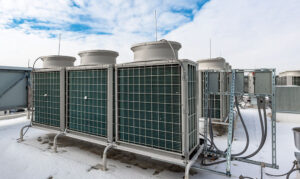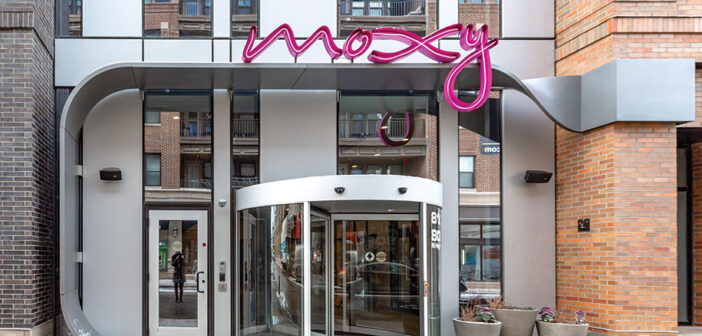When the 800 North High Street building, home to the Moxy Columbus Short North in Ohio, was being built, Crawford Hoying Development wanted to make sure that its mechanical systems could help balance costs through efficiency and design flexibility.
“When we approach a building like this, we’re constantly evaluating it on a bunch of different viewpoints,” said Nelson Yoder, principal, Crawford Hoying. “Energy efficiency is an important pillar along with aesthetics, occupant comfort and how the uses come together.”
The HVAC system they chose for the 10-story, 150,000-sq.-ft. building, which in addition to the Moxy, houses a coworking space and two restaurants, was the City Multi Variable Refrigerant Flow (VRF) systems from Mitsubishi Electric Trane HVAC US (METUS).

Developers of the Moxy Columbus Short North in Ohio chose City Multi Variable Refrigerant Flow (VRF) systems from Mitsubishi Electric Trane HVAC US
Engineers from PE Services specified 215 tons of Mitsubishi Electric VRF equipment. “One of the main benefits of this VRF system is that there are a number of unit types that can all be packaged for the infrastructure of the project,” said Craig Slaughterbeck, president, PE Services. “This is space-saving and helped us meet the needs of the architecture firm as we had to spatially allocate the HVAC system to fit within their desired aesthetic.”
Those aesthetics were a key concern for the building, especially for the Moxy portion, which is managed by Shaner Hotel Management. “For this project, we have 250 indoor units and the styles vary based on their location throughout the building,” said Bryan Crnarich, commercial regional manager, METUS. “In the hospitality areas of the building, it was really important to the ownership that we had ducted-style units. In the electrical areas, we have wall-mounted units and in the coworking space we have sleek, ductless ceiling cassettes.”
To meet Moxy’s brand standards as well as the local zoning authority’s criteria, Crawford Hoying had to keep a simple, clean look for the rooms. That criteria even applied to the mechanical systems.
“Many hotels have the grill underneath the window associated with a Packaged Terminal Air Conditioner (PTAC) unit,” said Yoder. “At this site, we have fantastic skyline views so the last thing we wanted to do was obscure them with a mechanical system. Besides our own aesthetic tastes, we couldn’t obtain zoning approval with a PTAC unit. Some agencies do not like this look. By going with Mitsubishi Electric VRF we were able to eliminate that as a concern. Besides, letting the mechanical system ‘disappear’ into a room is fantastic for creating an overall ambiance.”
The design flexibility of the VRF system was also a benefit, according to the developers, helping to create more usable, leasable and revenue-generating space for the building. The contractors at G Mechanical Inc. installed 90% of the mechanical systems for the building on a single platform located on the roof. “The Mitsubishi Electric outdoor units are allowed to sit so close together (while still running efficiently),” said Sean Minshall, project manager, G Mechanical Inc.
With such space-saving benefits, the architects were able to add a rooftop bar to the same level as the mechanical platform.
Crawford Hoying also liked the system’s compact, two-pipe system when designing the interior of the building. “This allowed us to save on both shaft construction, shaft wall construction on the front end, as well as realize some more income from leasable space throughout the lifecycle of the building,” said Yoder. “If you were to compare that with a unitary system, we’d have very large duct runs going down the corridor and coordination would have been a lot more difficult.”


